Food and beverages belong to the fast-moving consumer goods (FMCG) sector. For many years, this has remained one of Vietnam’s most vital and promising industries, with economic experts forecasting an annual growth rate of 5%–6% during the 2020–2025 period.
With a stable macroeconomic environment and numerous international commitments—such as the EU–Vietnam Free Trade Agreement (EVFTA) and the Comprehensive and Progressive Agreement for Trans-Pacific Partnership (CPTPP)—the industry is now enjoying unprecedented opportunities to expand exports, attract greater foreign investment, and benefit from technology transfers and advancements in technical expertise. Alongside this, food and beverage enterprises have continuously transformed in a positive direction, enhancing competitiveness and increasingly investing in infrastructure systems, including factories, warehouses, yards, as well as modernizing production processes and corporate management.
Despite the impacts of COVID-19, this period is also seen as a time of tremendous opportunity for Vietnam’s food and beverage industry. Consumers are increasingly shifting toward plant-based, organic, healthy, and convenient food products. Combined with the move from dining out to eating at home and growing concerns over imported food, the demand for certain food and beverage categories has surged and is expected to achieve notable breakthroughs in 2021 and beyond.
A recent quick survey conducted by Vietnam Report at the end of 2020 revealed that under the pressure of the COVID-19 pandemic, 50% of customers spent more on foods that enhance immunity and resistance, as well as on clean and healthy foods, while 63.7% reduced their spending on alcohol and beer. This reality has compelled companies in the sector to adjust their operating capacities accordingly. Food companies have had to increase capacity by around 30%, whereas beverage companies have reduced production to below 80% of pre-pandemic levels. Clearly, most food and beverage businesses have been impacted by COVID-19 in various ways.
According to Mr. Vu Dang Vinh, General Director of Vietnam Report, many leaders in the food and beverage sector believe that enterprises remain highly fragmented with weak financial capacity, making them more vulnerable to shocks like COVID-19. Such challenges force businesses to grapple with cash flow issues, staff reductions, and cost-cutting. Additionally, operations in this sector still lack coherent planning and a central governing body, leading to a “go it alone” or “village economy” mindset.
Nonetheless, the fundamental nature of human food consumption remains unchanged. Mr. Vinh stressed that as companies adapt to “living with the storm,” they face labor shortages and production constraints that fail to meet market demand—but most importantly, businesses must learn from such shocks. Remarkably, COVID-19 has acted as a catalyst, prompting nearly 70% of food and beverage companies to focus strongly on digital transformation. Many have built and implemented modern technological processes in production and management, proving resilient amid the crisis. Except for frontline factory workers who must rotate in shifts, all other operations can now be controlled and monitored remotely via software, apps, and camera systems—from warehousing, delivery, sales, distribution to meetings and conferences.
Many food and beverage companies are also taking advantage of this period to accelerate innovation efforts. They are revamping distribution systems, adjusting the balance between traditional and modern channels, developing apps to enhance customer shopping experiences, redesigning eco-friendly packaging and labels, and innovating new product lines aimed at boosting immunity and resistance.
Mr. Nguyen Dang Quang, Chairman of Masan Group, noted that amid difficulties, many food businesses are pioneering new solutions and directions to overcome the pandemic. To curb shortages and price spikes of essential goods, Masan’s food processing factories have been operating at full capacity, particularly in pork production. From an optimistic perspective, the COVID-19 pandemic presents an excellent opportunity to promote e-commerce. “The group is planning to encourage more consumers to shop online, so they can be served right at home without needing to physically visit supermarkets,” Mr. Quang emphasized.
In light of the pandemic and rising consumer demand, Mr. Vinh believes that food and beverage companies should prioritize strategies such as growing revenue, expanding current markets, intensifying R&D to enhance products, diversifying supply sources (favoring domestic suppliers), and developing online distribution channels through e-commerce platforms. These are hard-earned lessons distilled from the sector’s mistakes and challenges in coping with COVID-19 over the past year, Mr. Vinh concluded.
Ngoc Quynh (TTXVN)

